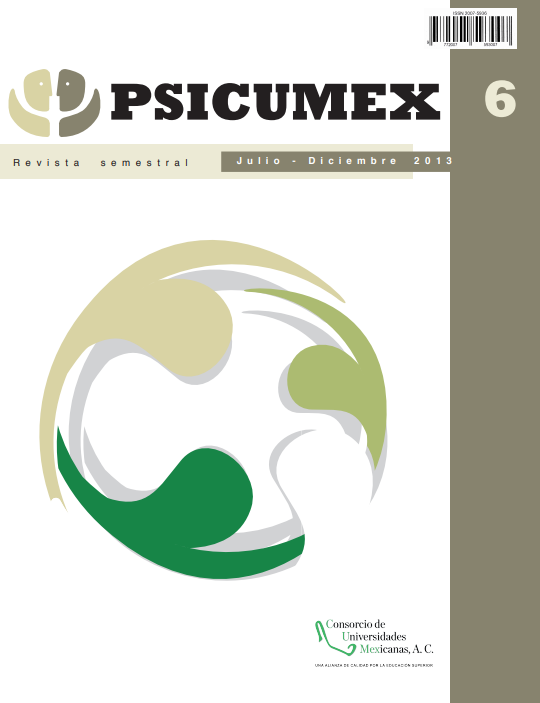Abstract
In order to identify the psychological meaning of the constructs: boy/girlfriend, fuckfriend, and free a questionnaire was administrated, following the semantic networks technique (Figueroa, Gonzáles, & Solís, 1981), but the procedure selected was proposed by Reyes (1993). The questionnaire was applied to a 230 participants, in which 32 of the participants had a relationship called as fuck friend, 29 had a relationship called free, 74 were in a courtship and 95 had no relationship. The instruments were applied individually and collectively in different schools in the municipality of Pachuca, Hidalgo; in all the cases anonymity was ensured. The results show that the stimulus fuck friend is defined by words like friendship, love, fun, understanding, and trust. The concept of a free is defined by aspects such as freedom, sex, friendship, fun and “no”. While boyfriends stimulus is defined by words like love, affection, honesty, respect, understanding and friendship. As mentioned Miller, Vandome and McBrewster (2010), casual relationships and casual sex are different. In relationships that are described as casual sex, there is no emotional interest by the person, they are not friends, and they do not give affection or love. Casual sex is a one night stand. In contrast, people that are involved in fuck friend relationships expect affection and love, the relationship lacks the commitment but not the part of intimacy: love and affection are in an informal relationship. Therefore, the results are discussed in terms of cultural and social changes that are present in the beginning and dissolution of relationships.
References
Camacho, J. (2004). Fidelidad e infidelidad de pareja. Buenos Aires: Dunken.
Castellanos, G. & Accorsi, S. (2002). Género y sexualidad en Colombia y en Brasil. Buenos Aires: La Manzana de la Discordia.
Figueroa, J., González, R., & Solís, V. (1981). Una aproximación al pro- blema del significado: las redes semánticas. Revista Latinoamericana de Psicología, 13(3), 447-458.
García, M. M. & Romero, P. A. (2011). Coerción sexual en el noviazgo. En R. Díaz y S. Robles (Eds.). Salud y Sexualidad. México: UNAM, CONACyT. AMEPSO.
García, M. M. & Reyes-Lagunes, L. I. (2004). Amor y desamor: del matrimonio al divorcio. La Psicología Social en México, X. México: AMEPSO.
García, M. M. & Reyes-Lagunes, L. I. (2009). Actitudes hacia el matrimonio y el divorcio: Diferencia por sexo, residencia y estatus de pareja. Psicología Iberoamericana, 17(1), 48-56.
Kandel, E. (2003). Understanding violence (2a ed). New Jersey: Lawrence Erlbaum associates.
Mendoza, I. & Fraao, V. M. (2005). Berlitz Vorsicht Spanisch! München: Berlitz Publishing.
Miller, F. P., Vandome, A. F., & McBrewster, J, (2010). Casual relationships. US: Publishing House Ltd.
Nateras, A. (2004). Los trazos de lo emergente juvenil urbano. En S. Arciga B. (Ed.). Del pensamiento social a la participación. Estudios de psicología social en México. México: SOMEPSO, Universidad Autónoma de Tlaxcala, UNAM, UAM-Iztapalapa.
Osgood, Ch., Suci, G., & Tannembaum, T. (1971). The measurement of meaning. Chicago: The University of Illinois Press.
Paulinas (2007). Entre el goce, el afecto y los temores jóvenes y sexualidad. Bogotá: Editor Paulinas.
Reyes-Lagunes, I. (1993). Las redes semánticas naturales, su conceptualización y su utilización en la construcción de instrumentos. Revista de Psicología Social y Personalidad, 9(1), 81-97.
Sternberg, J. R. (2000). La experiencia del amor: la evolución de las relaciones amorosas a lo largo del tiempo. México: Paidos.
Szalay, L. & Bryson, A. (1973). Measurement of psichocultural. Journal of personality and social psychology, 26(2), 166-167.
Wentland, J. J. (2007). Sexual pleasure orientation in heterosexual women. University of Guelph thesis. University of Guelph. Dept. of Family Relations and Applied Nutrition, University of Guelph. School of Graduate Studies.

This work is licensed under a Creative Commons Attribution-NonCommercial-NoDerivatives 4.0 International License.
Copyright (c) 2013

